
![]() This
is the name given to a brimless, limp, conical cap fitting
snugly around the head. It is supposed to have been worn
by the inhabitants of Phrygia, a region of central Anatolia
in antiquity.
This
is the name given to a brimless, limp, conical cap fitting
snugly around the head. It is supposed to have been worn
by the inhabitants of Phrygia, a region of central Anatolia
in antiquity.
![]() The
book Iconologia by Cesare Ripa (first edition 1593)
and other works from the sixteenth and seventeenth centuries
describe and depict the cap. As these works state, the Phrygian
cap was worn by liberated slaves in ancient Rome and Greece.
It was also worn on special occasions afterwards. In fact
the cap played a minor role in the slave manumission ceremony.
Its link with Phrygia in Minor Asia is also tenuous. The
idea seems to have been that Phrygia was a source of slaves
who when freed - if freed - would once again don their traditional
headgear. Whatever the truth, the Phrygian cap was picked
up and used as a symbol of liberty by libertarians during
the Enlightenment. The "Phrygian cap" (in French,
bonnet Phrygian) is almost invariably depicted
in red and is sometimes called red cap (bonnet rouge) or
liberty cap (bonnet de la Liberté).
The
book Iconologia by Cesare Ripa (first edition 1593)
and other works from the sixteenth and seventeenth centuries
describe and depict the cap. As these works state, the Phrygian
cap was worn by liberated slaves in ancient Rome and Greece.
It was also worn on special occasions afterwards. In fact
the cap played a minor role in the slave manumission ceremony.
Its link with Phrygia in Minor Asia is also tenuous. The
idea seems to have been that Phrygia was a source of slaves
who when freed - if freed - would once again don their traditional
headgear. Whatever the truth, the Phrygian cap was picked
up and used as a symbol of liberty by libertarians during
the Enlightenment. The "Phrygian cap" (in French,
bonnet Phrygian) is almost invariably depicted
in red and is sometimes called red cap (bonnet rouge) or
liberty cap (bonnet de la Liberté).
It was used by a series of revolutionaries - who seem to have picked up the symbol one from another. There is some doubt as to whether the French Revolutionaries got it from the American Revolutionaries, or whether the American Revolutionaries had got it from pre-revolutionary French ideologues. Since the American Revolution came a few years before the French, American iconography can be used as a sort of introduction.
The liberty cap is one of the gererally recognised symbols of sovereignty not mentioned in article 2 of the French Constitution of 1958, which refers only to le drapeau tricolore, bleu, blanc, rouge: The French Flag , L'hymne national, the national anthem, The Marseillaise and La devise de la République; the motto . "Liberté, Égalité, Fraternité".
The Liberty Cap in North America. In the American colonies the Liberty Cap had been was used, perhaps a little melodramatically, by the Sons of Liberty in 1765. During the American Revolution some soldiers who fought for the rebel cause wore knitted stocking liberty caps of red. Sometimes they had the motto "Liberty" or "Liberty or Death" knitted into the band. This style of cap was common in the North East (possibly reflecting French influence). "Jonathan" (the allegorical figure of colonial New England) is sometimes shown wearing a liberty cap.
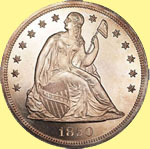
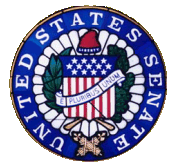
![]()
![]() Liberty
caps were sometimes held aloft on a Liberty Pole during
the American
Revolutionary War as a symbol of freedom. It is not clear
whether the idea of using these caps was imported from France.
The liberty cap, or something like it, was already associated
with revolt against established authority in France. The
Revolt of the Red Caps for example was a series of riots
in Brittany in 1675 triggered by Colbert's taxes. The coin
(of 1850) on the left shows Liberty holding a Liberty Pole
with a Phrygian hat on it. On the right is the Liberty Seal
of the US Senate with a Liberty cap surmounting the arms
in the centre and crossed fasces
underneath.
Liberty
caps were sometimes held aloft on a Liberty Pole during
the American
Revolutionary War as a symbol of freedom. It is not clear
whether the idea of using these caps was imported from France.
The liberty cap, or something like it, was already associated
with revolt against established authority in France. The
Revolt of the Red Caps for example was a series of riots
in Brittany in 1675 triggered by Colbert's taxes. The coin
(of 1850) on the left shows Liberty holding a Liberty Pole
with a Phrygian hat on it. On the right is the Liberty Seal
of the US Senate with a Liberty cap surmounting the arms
in the centre and crossed fasces
underneath.

![]() A
Liberty cap - oddly a golden one - features in the arms
of New York, the original national capital of the USA. The
dexter supporter to the arms is blazoned as follows: "The
figure of Liberty proper, her hair disheveled and decorated
with pearls, vested azure, sandaled gules, about the waist
a cincture or, fringed gules, a mantle of the last depending
from the shoulders behind to the feet, in the dexter
hand a staff ensigned with a Phrygian cap or, the sinister
arm embowed, the hand supporting the shield at the dexter
chief point, a royal crown by her sinister foot dejected."
(In the language of heraldry the word "or" means
gold).
A
Liberty cap - oddly a golden one - features in the arms
of New York, the original national capital of the USA. The
dexter supporter to the arms is blazoned as follows: "The
figure of Liberty proper, her hair disheveled and decorated
with pearls, vested azure, sandaled gules, about the waist
a cincture or, fringed gules, a mantle of the last depending
from the shoulders behind to the feet, in the dexter
hand a staff ensigned with a Phrygian cap or, the sinister
arm embowed, the hand supporting the shield at the dexter
chief point, a royal crown by her sinister foot dejected."
(In the language of heraldry the word "or" means
gold).
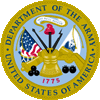
![]()
![]()
![]() A
Liberty Cap appears on the State flags of West Virginia
and New Jersey as well as the official seals of the United
States Army and the United States Senate. A Liberty Cap
also features on the seal of Dickinson College, in Carlisle,
Pennsylvania, the first college to be chartered in the new
Republic of the USA.
A
Liberty Cap appears on the State flags of West Virginia
and New Jersey as well as the official seals of the United
States Army and the United States Senate. A Liberty Cap
also features on the seal of Dickinson College, in Carlisle,
Pennsylvania, the first college to be chartered in the new
Republic of the USA.


![]()
![]()

![]() The
figure on the left is a detail from the US Senate's painting
Telegraph by Constantine Brumidi showing a female
personification of "America" wearing a Liberty
Cap. Although the Liberty cap - or cap of Liberty - is so
common in US revolutionary iconography, it is curious that
it is rarely shown being worn. It is shown either as an
isolated symbol, or on top of a Liberty pole or similar
support. The one on the near right is coloured like an American
flag and held on a pole. The design on the far right features
another Liberty cap also on a pole along with a fasces.
This design was taken from an envelope dating from the American
Civil War.
The
figure on the left is a detail from the US Senate's painting
Telegraph by Constantine Brumidi showing a female
personification of "America" wearing a Liberty
Cap. Although the Liberty cap - or cap of Liberty - is so
common in US revolutionary iconography, it is curious that
it is rarely shown being worn. It is shown either as an
isolated symbol, or on top of a Liberty pole or similar
support. The one on the near right is coloured like an American
flag and held on a pole. The design on the far right features
another Liberty cap also on a pole along with a fasces.
This design was taken from an envelope dating from the American
Civil War.
Plans for the new dome of the national Capitol, which was authorized in 1855 included an allegorical figure of Liberty (called "Freedom triumphant in War and Peace") wearing a Liberty cap. Jefferson Davis (then Secretary of War) objected to the Liberty cap so the architect replaced it with a rather eccentric Roman helmet (See Liberty).

![]() The
Liberty Cap in France. The Phrygian cap (in French,
bonnet Phrygian) is also known in French as the
Liberty cap (bonnet de la Liberté) or as a red cap
(bonnet rouge). It was adopted during the French Revolution.
Liberty
is sometimes shown wearing a Phrygian cap. So is Marianne.
Representations of soldiers in the French revolutionary
army show them wearing liberty caps as part of their uniforms
- as in the picture on the right.
The
Liberty Cap in France. The Phrygian cap (in French,
bonnet Phrygian) is also known in French as the
Liberty cap (bonnet de la Liberté) or as a red cap
(bonnet rouge). It was adopted during the French Revolution.
Liberty
is sometimes shown wearing a Phrygian cap. So is Marianne.
Representations of soldiers in the French revolutionary
army show them wearing liberty caps as part of their uniforms
- as in the picture on the right.
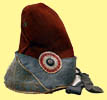
![]()

![]() In
revolutionary France the use of the Liberty cap is documented
from 1789, but the cap became a popular symbol only in the
spring of 1790. It was initially worn by goddesses Liberty
and Nation (the latter later morphing into Marianne).
In 1792, it became part of the uniform of the sans-culottes.
On 20 June 1792, King Louis XVI was obliged to don a liberty
cap by a crowd that had stormed the palace of Tuileries.
When the Archbishop of Paris was forced to resign his duties
he was made to replace his mitre with the red Cap of Liberty.
In
revolutionary France the use of the Liberty cap is documented
from 1789, but the cap became a popular symbol only in the
spring of 1790. It was initially worn by goddesses Liberty
and Nation (the latter later morphing into Marianne).
In 1792, it became part of the uniform of the sans-culottes.
On 20 June 1792, King Louis XVI was obliged to don a liberty
cap by a crowd that had stormed the palace of Tuileries.
When the Archbishop of Paris was forced to resign his duties
he was made to replace his mitre with the red Cap of Liberty.
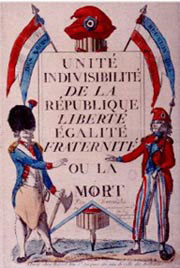

![]()
![]() After
the fall of the French monarchy, the Liberty cap became
more common. It coiffed representations of Liberté,
sometimes sitting, sometimes standing. It also appeared
on top of pikes and flag poles, Liberty trees, Fasces
of Unity, Triangles of Equity and atop the scales
of Justice. On the left a Liberty cap is shown being worn
by a soldier, and another one hides the ax head of the fasces
just visible behind the banner.
After
the fall of the French monarchy, the Liberty cap became
more common. It coiffed representations of Liberté,
sometimes sitting, sometimes standing. It also appeared
on top of pikes and flag poles, Liberty trees, Fasces
of Unity, Triangles of Equity and atop the scales
of Justice. On the left a Liberty cap is shown being worn
by a soldier, and another one hides the ax head of the fasces
just visible behind the banner.
![]()
![]() By
1793, members of the Assemblies of Paris were obliged to
wear a Liberty cap. The Convention accepted it as a national
symbol and had it placed on the French
Seal of State of the Republic and also on milestones
(to replace the royal fleur-de-lis).
By
1793, members of the Assemblies of Paris were obliged to
wear a Liberty cap. The Convention accepted it as a national
symbol and had it placed on the French
Seal of State of the Republic and also on milestones
(to replace the royal fleur-de-lis).
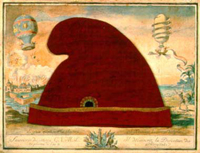
![]() The
cap was clearly regarded as an importannt icon - on the
right is a portrait of one. It seems always to have been
associated with the more extreme revolutionaries and so
has always faded into the background during periods of stability
when French governments are keen to discourage new revolutionary
ideas. Under the Consulate, the capped Liberty was replaced
by a less revolutionary helmeted Minerva. Liberty caps were
removed from all public monuments.
The
cap was clearly regarded as an importannt icon - on the
right is a portrait of one. It seems always to have been
associated with the more extreme revolutionaries and so
has always faded into the background during periods of stability
when French governments are keen to discourage new revolutionary
ideas. Under the Consulate, the capped Liberty was replaced
by a less revolutionary helmeted Minerva. Liberty caps were
removed from all public monuments.
Napoleon is reported to have detested the Phrygian cap.
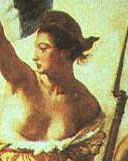
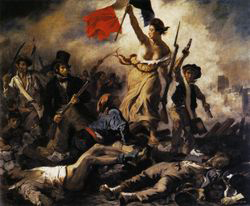
![]()
![]() The
picture on the left is called La Liberté guidant
le peuple (Liberty Guiding the People). It is
by Eugene Delacroix and hangs in the Louvre in Paris. In
it, Liberty is brandishing a French
tricolore flag and wearing a red Phrygian cap - which
you can just about make out in the detail on the right.
The painting was inspired by the insurrection of July 1830
in Paris during which the last king of France (Charles X)
was forced to abdicate and was replaced by the 'King of
the French' Louis-Philippe. Apparently there is some subtlety
in the different titles that must have carried significance
at the time.
The
picture on the left is called La Liberté guidant
le peuple (Liberty Guiding the People). It is
by Eugene Delacroix and hangs in the Louvre in Paris. In
it, Liberty is brandishing a French
tricolore flag and wearing a red Phrygian cap - which
you can just about make out in the detail on the right.
The painting was inspired by the insurrection of July 1830
in Paris during which the last king of France (Charles X)
was forced to abdicate and was replaced by the 'King of
the French' Louis-Philippe. Apparently there is some subtlety
in the different titles that must have carried significance
at the time.

![]() During
the Second Republic, insurrectionists forced the provisory
government to add a liberty cap on the white stripe of the
French
tricolore flag around February 1848. The cap then disappeared
again - not only from the flag but also from the French
Seal of State of the Second Republic. It was reestablished
as national symbol during the Third Republic.
During
the Second Republic, insurrectionists forced the provisory
government to add a liberty cap on the white stripe of the
French
tricolore flag around February 1848. The cap then disappeared
again - not only from the flag but also from the French
Seal of State of the Second Republic. It was reestablished
as national symbol during the Third Republic.
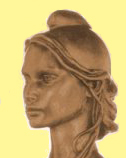
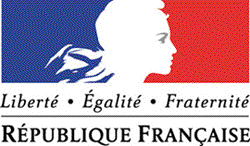
![]()

![]()

![]() The
liberty cap is still worn by Marianne,
the feminine representation of the French Republic; but
only sometimes. Her bust, which adorns city halls of France,
sometimes sports a rather less revolutionary tiara. She
wears a very discreet Liberty cap on the new
French logo shown above.
The
liberty cap is still worn by Marianne,
the feminine representation of the French Republic; but
only sometimes. Her bust, which adorns city halls of France,
sometimes sports a rather less revolutionary tiara. She
wears a very discreet Liberty cap on the new
French logo shown above.
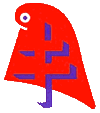

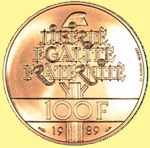
![]() A
Liberty cap is visible on the 1989 100 franc coin shown
on the right. Until 2002 the cap appeared, along with the
Cross of Lorraine, on the logo of a right-wing French
political party called Rassemblement pour la République
(RPR), the neo-Gaullist party of Jacques Chirac. The logo
is no longer used, perhaps because of the forgivable tendency
to see it as as a deformed parrot. (The parot's "eye" is
actually a blue,
white and red cockade.)
A
Liberty cap is visible on the 1989 100 franc coin shown
on the right. Until 2002 the cap appeared, along with the
Cross of Lorraine, on the logo of a right-wing French
political party called Rassemblement pour la République
(RPR), the neo-Gaullist party of Jacques Chirac. The logo
is no longer used, perhaps because of the forgivable tendency
to see it as as a deformed parrot. (The parot's "eye" is
actually a blue,
white and red cockade.)
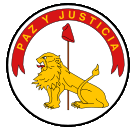
![]() Other
Countries. Elsewhere, the cap was incorporated
into the symbol of the late 18th century Irish revolutionary
movement known as the Society of the United Irishmen. It
also carried over to Latin American
revolutions of the 1820s. The cap appeared on Mexican coins
through the late 19th century into the mid 20th century
(including the old 8 Reales coin). Today, it is featured
of the coats of arms, national flags or seals of Nicaragua,
El Salvador, Colombia, Paraguay and Cuba. In Argentina it
appears not only on the national arms and flag, but also
those of the army and navy, on presidential flags and the
flags of provinces including Corrientes, Jujuy, Mendoza
and San Juan. As in the US, the cap invariably seems to
feature on top of a stick, rather than people's heads.
Other
Countries. Elsewhere, the cap was incorporated
into the symbol of the late 18th century Irish revolutionary
movement known as the Society of the United Irishmen. It
also carried over to Latin American
revolutions of the 1820s. The cap appeared on Mexican coins
through the late 19th century into the mid 20th century
(including the old 8 Reales coin). Today, it is featured
of the coats of arms, national flags or seals of Nicaragua,
El Salvador, Colombia, Paraguay and Cuba. In Argentina it
appears not only on the national arms and flag, but also
those of the army and navy, on presidential flags and the
flags of provinces including Corrientes, Jujuy, Mendoza
and San Juan. As in the US, the cap invariably seems to
feature on top of a stick, rather than people's heads.
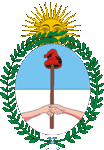

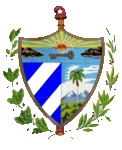
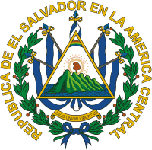
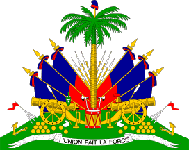
The
Phrygian Cap before it became a Liberty Cap



![]() Before
the Phrygian cap came to symbolise freedom or revolutionary
fervour, it had another signification in the west. It was
a symbol associated with the east. Indeed it seems to have
been worn by arange of peoples in the Balkans and Asia Minor.
Macedonian, Thracian, and Dacian military helmets all had
forward pointing tops perhaps mimicking Phrygian caps.
Before
the Phrygian cap came to symbolise freedom or revolutionary
fervour, it had another signification in the west. It was
a symbol associated with the east. Indeed it seems to have
been worn by arange of peoples in the Balkans and Asia Minor.
Macedonian, Thracian, and Dacian military helmets all had
forward pointing tops perhaps mimicking Phrygian caps.

 The
Phrygian cap can be seen on Trajan's Column, worn by the
Dacians, and on the Arch of Septimius Severus, worn by the
Parthians. Roman poets habitually used the term "Phrygian"
to mean Trojan. In Greek art, the Phrygian cap served to
identify Paris as a Trojan - and so definitely not a proper
Greek. The mosaic on the right shows Orpheus wearing a Phrygian
hat. The cap also appears on murals in a 4th century Thracian
tomb at Kazanlak in modern Bulgaria.
The
Phrygian cap can be seen on Trajan's Column, worn by the
Dacians, and on the Arch of Septimius Severus, worn by the
Parthians. Roman poets habitually used the term "Phrygian"
to mean Trojan. In Greek art, the Phrygian cap served to
identify Paris as a Trojan - and so definitely not a proper
Greek. The mosaic on the right shows Orpheus wearing a Phrygian
hat. The cap also appears on murals in a 4th century Thracian
tomb at Kazanlak in modern Bulgaria.

![]()
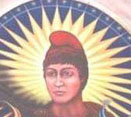
![]()

![]() The
Phrygian cap was worn by the god Mithras - shown on the
right. He was a Saviour god in the Dualist Persian tradition
based on the Zoroastrian religion. Mithras was a forerunner
of the Saviour-god Jesus Christ who borrowed Mithras's halo,
his birthday and his temple on the Vatican Hill in Rome,
but not his Phrygian hat. The same headgear also features
on the heads of the Three Magi in old depictions of them
- marking them as being from the east, like this depiction
(above left) from a church in Ravenna. The name Magi denotes
Zoroastrian priests from Persia.
The
Phrygian cap was worn by the god Mithras - shown on the
right. He was a Saviour god in the Dualist Persian tradition
based on the Zoroastrian religion. Mithras was a forerunner
of the Saviour-god Jesus Christ who borrowed Mithras's halo,
his birthday and his temple on the Vatican Hill in Rome,
but not his Phrygian hat. The same headgear also features
on the heads of the Three Magi in old depictions of them
- marking them as being from the east, like this depiction
(above left) from a church in Ravenna. The name Magi denotes
Zoroastrian priests from Persia.

![]()

![]()
![]()
![]() Curiously,
Mr Punch, as in Punch and Judy, always wears a red Phrygian
cap - did he originally come from the east?
Curiously,
Mr Punch, as in Punch and Judy, always wears a red Phrygian
cap - did he originally come from the east?
Smurfs wear them too!
The name Liberty cap also denotes a type of mushroom that looks reminiscent of a Liberty Cap on top of a Liberty Pole.




